The collective memory of eugenics is that it was an ideology of archconservatives that thrived during the first half of the 20th century and whose demise was hastened by the horrors of Nazi Germany. We like to think that we now know better. Better science, better morals, better guiding ethical principles. Heck, we must even be better people. It may be a comforting story, but historians of science have been pointing out for decades that this collective memory is flawed. Eugenic ideologies and policies, usually under different labels and in various forms, can be found today in science, medicine, and social policies.
Strands of eugenic beliefs also became embedded into popular culture. For example, as historian of science Paul Lombardo has demonstrated, references to eugenics could be found in the advertisements of popular magazines and newspapers in the first half of the 20th century, suggesting that the average American was familiar enough with eugenics that the term needed no explanation. For marketing purposes, eugenics implied excellent consumer products such as diamonds, hair styles, and hair shoes, in much the same way that many companies today will state that the quality of its products or the company’s dedication to customer service is part of the company’s DNA. There are many other examples of eugenic themes in 20th and 21st century novels, films, comics, and video games.
Along these lines, I recently came across two Walt Disney cartoons that echo eugenic themes. I couldn’t believe it at first. I thought maybe it was just my hyperactive eugenics paranoia kicking in and deluding me. After all, I tend to see eugenic monsters lurking under my bed at night. But the more I studied the cartoons, the more convinced I became.
Disclaimer: I have no reason to believe that Walt Disney himself was a dyed-in-the-wool eugenicist or that the Walt Disney Company is a front for a nefarious eugenics media empire. Rather, these cartoons illustrate how eugenic ideology was so pervasive that it subtly and not so subtly became woven into the fabric of American popular culture. It could appear in a cartoon without the creators having a single eugenic bone in their body. Or it could manifest under a different name, so disguised that a cartoonist might not recognize it for what it was.
The first cartoon, Goofy’s Adventure Story from 1954, tells the story of the family history of the Disney character Goofy. Goofy is an anthropomorphized dog who first appeared in 1932 – the heyday of classic eugenics – as the character Dippy Dawg. The cartoon includes a family tree in reverse order of tree growth, i.e., with the ancestral Caveman Goofy at its apex and 1950s Goofy at its base (which, curiously, is how family trees were typically drawn until about the 15th century). Descending between the two is a lineage of historical Goofy characters. Each ancestor is basically a stereotypical White European (for the moment, ignoring Goofy’s canine heritage*). In the cartoon, each character does something, well, goofy, in keeping with the character’s namesake trait. Goofy appears to be part of a patrilineal society since there are no female ancestors on the tree.
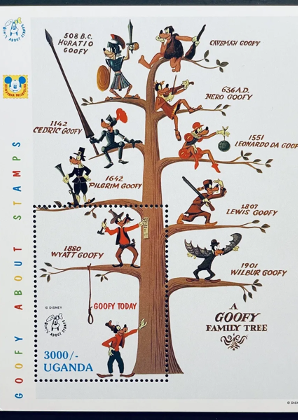
/400×400/730f6beb335f248cfe85fdbb46a85728/o/e/oepb175.jpg
The family tree was a powerful symbol for eugenicists, who recognized the value of graphics in getting their point across. The many pedigrees of “feeble-minded” families produced by eugenicists were used to “prove” that intelligence was inherited in Mendelian fashion and that the people at the lower end of the intelligence spectrum were breeding at such incredible rates that the very existence of society was threatened by their reproductive drive, low intelligence, and propensity to crime and poverty. The pedigrees of “feeble-minded” families – typically poor and from “degenerate races” – reflected the race and class biases of eugenicists, who were primarily economically well-off Northern and Western White men.
Goofy’s family tree is a variation on these eugenic pedigrees. Goofy’s tree is peopled with Noble White Man tropes so beloved by eugenicists, such as Roman emperors, Greek warriors, knights in armor, and Pilgrims. In keeping with Goofy’s nature, these figures are presented in comic form. But the comic form gets at the essence of the connection to eugenics. Think about it for a moment – the name Goofy is synonymous with “feeble-minded,” a connection reinforced by his signature “Hyuk, Hyuk” laugh and two widely-separated upper teeth (which don’t look like canines to see). Disney, of course, wasn’t trying to revive classic eugenics. Rather, Goofy’s pedigree illustrates how the eugenic notion that intelligence was inherited and ran for generations within families was so engrained into the public consciousness that, even without thinking about eugenics. it was natural to create a “feeble-minded” cartoon character who has a family tree full of “feeble-mindedness.” Goofy’s family history is a modified and cartoonized version of the pedigrees of the Jukes, the Kallikaks, the Hill Folk, the Mongrel Virginians, the Pineys, the Nam Family, and the many other “degenerate” families described by eugenicists.

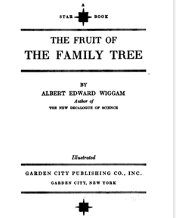
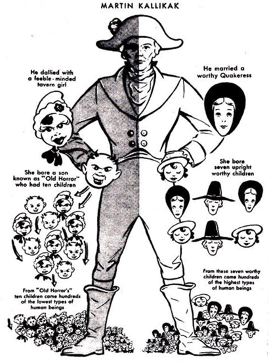
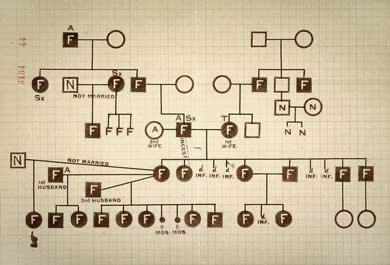
https://dnalc.cshl.edu/view/15749-Pedigree-of-feeblemindedness.html.
The Goofy family tree also includes an odd appendage, one that I have decided to believe is unintentionally inappropriate and reflective of what was considered acceptable at the time rather than a, uh, racist dog whistle. Dangling from the lowest branch on the left is a noose. I am not exactly sure what a noose is doing here although I guess it’s somehow connected to Wyatt Earp Goofy, who appears to be nailing a Wanted poster to a tree. Not that I expect a cartoon to be historically accurate, but Earp is not particularly associated with hangings, and in fact helped disperse a mob that was intent on hanging a man accused of murder. The noose, of course, is an image used by White supremacist racists to try to strike fear in the hearts of Black people in America. Along these lines, in the cartoon Wild Bill Goofy shoots a Native American in a manner that’s somehow supposed to be humorous, and the appearances of Native Americans and South Seas “cannibals” are depicted stereotypically.
In another weird twist, the country the Goofy Family Tree appeared on a postal stamp issued by Uganda in 1992, celebrating the 60th anniversary of the creation of the Goofy character (Disney characters were licensed for use on postage stamps in many countries).
In the other eugenic-themed Disney cartoon, titled Family Planning, Donald Duck helps a disembodied narrator explain family planning. The cartoon does not detail the specific methods of family planning other than “taking pills” and “using simple devices.” Just as well, I guess. I for one was not interested in Donald Duck demonstrating how to use a condom or Donald and Daisy practicing the rhythm method.
This educational cartoon was produced in 1968 for the Population Council by Walt Disney Productions and scripted by Disney veteran Bill Bosché. This organization was founded with money from the Rockefellers, who had a history of funding eugenics organizations and initiatives, to help solve the supposed problem of global over-population. Today, the Population Council has a very different focus and set of values, but in the 1950s and 1960s it was primarily concerned with the planet’s growing population, especially in poorer countries (India seemed to be a particular concern) and urban centers in the US with large populations of Blacks and Mexican Americans.
Some of the Population Council’s early presidents had strong ties to pre-World War II eugenics, most notably Frederick Osborn. Osborn helped create the journal Eugenics Quarterly, was a founding member of the American Eugenics Society and a member of Britain’s Eugenics Society, and once characterized Nazi eugenics as “an important experiment.” After WWII, he apparently had a fall-off-his-ass experience and began portraying himself as a severe critic of classic eugenicists such as his uncle Henry Fairfield Osborn. He shifted his focus to positive eugenics (i.e., encouraging the “right” people to breed and encouraging the “wrong” people to voluntarily curb reproduction) and acknowledged the role that environment played in an individual’s development and lot in life, what might euphemistically be called a kindler, gentler eugenics.
Despite Osborn’s claim to the contrary, these two quotes from 1965 and 1963, respectively, demonstrate that he had not fully shed some of his hard core eugenic beliefs:
…the average genetic character of parents of unwanted children is likely in the long run to be below average. An unusual proportion of these unwanted children grow up to be juvenile delinquents, unemployed, or social charges.
Every racial group has a certain proportion of genes for high ability…. It appears that ever since World War II, Negroes as a group have been increasing in numbers more rapidly than the Whites, with a probable trend during this period towards producing relatively fewer able individuals. This is the kind of dysgenic situation which eugenics aims to ready.
Osborn was no longer president when the cartoon was produced and as far as I know did not play a role in developing it. But his eugenic philosophy strongly influenced the organization’s policies during the 1960s. It’s this Osbornian view of humanity that guides the message of the Disney cartoon.
The cartoon’s central character is a peasant farmer with a skin tone a shade or two darker than white and who speaks English with what sounds to me like a Central American accent. When the family has only 3 children, the farmer is able to provide for his family – enough food, schooling, and a few simple possessions such as a radio. But, according to the cartoon, if the family goes on to have 4 more children, the farmer will no longer be able to provide enough food or otherwise meet the basic needs of his family. The parents become so tired they can barely care for their children, who grow weak and sickly. When the sons grow up, the small family plot will have to be divided among them, restricting their ability to care for their families. Heaven forbid, should the family move to the city they will be even worse off because they can’t afford to live there. The narrator’s solution is for the peasant to practice family planning so that reproduction is not “left to chance” and “you can only have the children you want.”

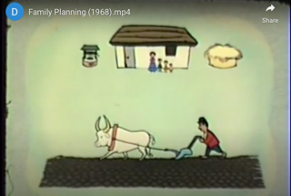
Eugenic themes were not confined to cartoons. They can be found in other areas of popular culture from that era and even up to today. The Beverly Hillbillies (“a poor mountaineer who barely kept his family fed”) are the cultural descendants of Charles Davenport’s Hill Folk. As are the inhabitants of the hills of northern Georgia in James Dickey’s novel Deliverance (“Nobody worth a damn could ever came from this place.”) who terrorized the rich urban men seeking to display their manhood by spending a weekend rafting a wild river. Or, from a previous generation, the immigrant-hating horror novelist H.P. Lovecraft who wrote of unimaginable alien horrors lurking in the hills of New England (“West of Arkham the hills rise wild… When I went into the hills they told me the place was evil.”). In a clever thematic manipulation, the current TV series Lovecraft Country features Black characters facing the monsters of White racism across America’s 1950s South.
The current spate of zombie movies, novels, and television shows can be read as eugenic, with their mutated throngs of human monsters threatening the existence of Western civilization. Perhaps it’s no coincidence that the popularity of the zombie genre is blossoming during a time of anti-immigrant sentiment in Europe, America, and other places. Eugenics has an uncanny ability to morph and adapt to different times and different cultural milieus. And, like zombies, it refuses to die.
_____________________________________________________
- – Someone really should perform whole genome sequencing on Goofy and Pluto to finally resolve the long-standing debate about the differences between the two, Goofy being a canine who is bipedal, language fluent, and a friend of Mickey Mouse whereas Pluto is a quadrupedal canine, incapable of speaking, and is Mickey’s pet. Surely the difference lies in their genomes.

I always love reading your posts, Bob. You have a very entertaining way of bringing up deep topics and encouraging us to think. I agree with everything you said, but do find useful wisdom in the family planning cartoon. It is true that people should consider how many kids they are able to support before they board that train. So that part I have no problem with. That message shouldn’t be directed to only one ethnic group or other specific group, however… everyone needs to be responsible for planning their future.
Roxanne - Thank you for thoughtfully reading the blog posting. You bring up an important point about the message of how many kids they are able to support. But in the context of the blatant eugenic policies with their race biases, that message in the cartoon is basically a wolf in sheep’s clothing. They couldn’t come out and say “All you darker-skinned people need to stop having so many kids.” That would have been considered inappropriate to say it so blatantly. So they snuck the eugenics in under the guise of “helping out the poor families.” Especially for poor, rural families, larger family size is very important because of the high infant mortality rate, the benefit of having help with farming, household chores, care of family members, religious and cultural values, etc.
Bob
There is an academic text by a theatre historian called “Mendel’s Theatre” (the name of an actual eugenics display that travelled around in the early 20th century) about how prevailing beliefs about heredity made there way into the works of many playwrights. It’s everywhere!
Leslie – thanks for reminding me of that. A photo of the actual mini-theater, which illustrated the inheritance of hair color (which I don’t really understand myself), can be found here: https://dnalc.cshl.edu/view/10010–Mendel-s-Theatre-showing-inheritance-of-hair-color-demonstrated-by-Leon-Fradley-Whitney.html.
I believe the book you’re referring to is Susan Currell’s “Mendel’s Theatre: Heredity, Eugenics, and Early Twentieth-Century American Drama,” which came out in 2010.
Bob
All correct, except the author was Tamsen Wolff and it came out in 2009 (you’re probably looking at Susan Currell’s review of it the next year).
Oops, my rushed mistake. You’re absolutely correct, Leslie. Thanks for pointing it out.